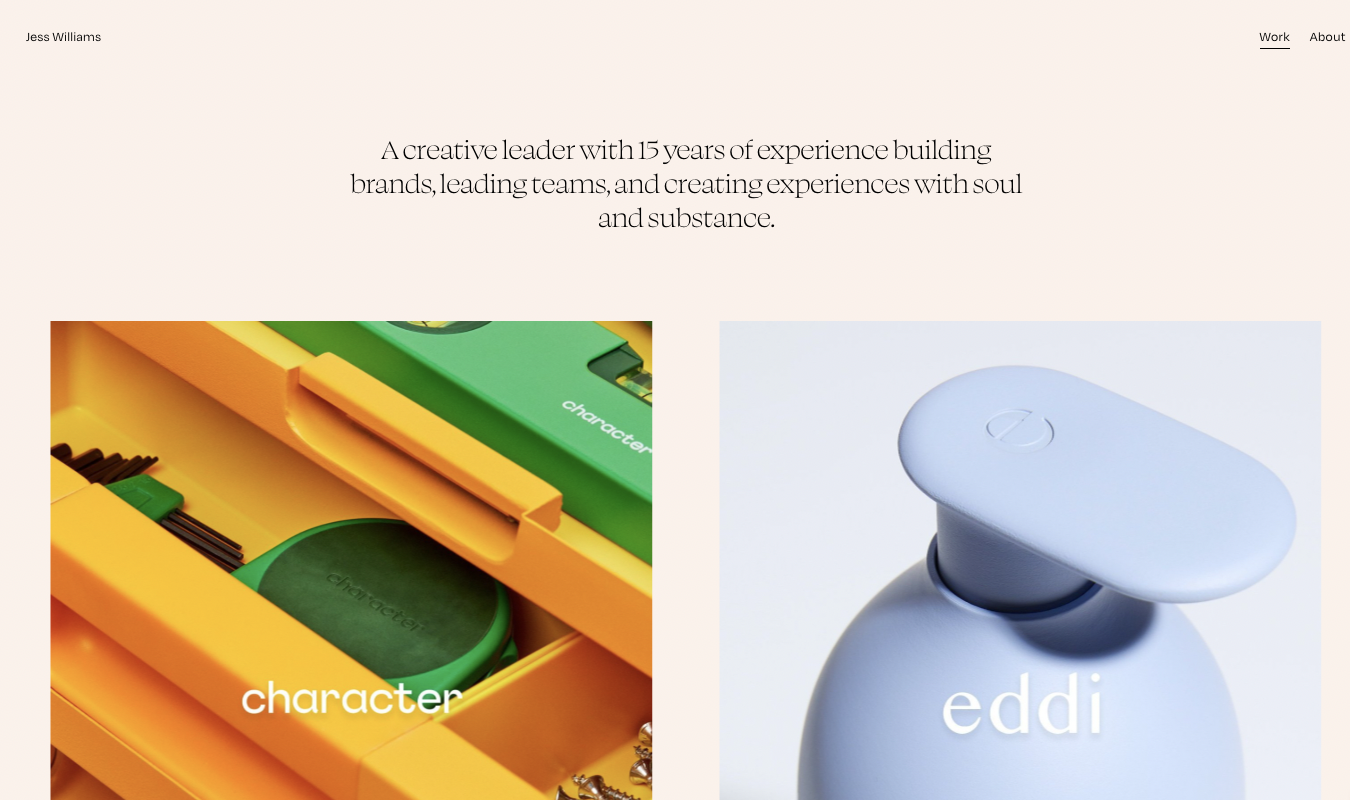Wix is a free and user-friendly website building platform that comes packed with some powerful built-in features. It’s easy to see why over 110 million users prefer it over others.
It has an intuitive technology, drag-and-drop editor, and hundreds of attractive and functional templates, making it our top pick for the best website builders you can get your hands on. From blogs to business websites to ecommerce stores, Wix can do it all and do it well.
But how to get started with the platform? Read on to find out.
Why Wix is Worth It
Put simply, Wix is fantastic.
It comes with a complete set of tools to build a solid online presence. Plus, you have the freedom to design professional-looking websites with incredible ease—without knowing a single line of code.
Small businesses, creatives, and beginners adore Wix’s feature-rich interface. In addition to the plethora of apps and SEO tools, the platform offers over 800 professionally designed and fully customizable templates. As a result, there‘s no need for you to do any hard work when building your website.
And Wix takes care of some of the bigger backend needs for you. Namely, they offer 24/7 managed security on all plans, maintaining the highest level of security standards for all users’ sites and monitoring and optimizing without you having to lift a finger.
They also do a lot of work to make sure their infrastructure is reliable so that your site is always available. Automated backups of your site data are stored across multiple servers, so you can recover your site if ever something goes wrong. And those servers work together, running on AWS, Google Cloud, and other platforms, to ensure site availability at all times, even during backend maintenance.
What’s more, the service is free and offers something for everyone. Yes, anyone with a computer can use Wix free of charge for as long as they want and create as many sites as they want.
You also get access to Wix’s App Market, which offers over 250 professional solutions to customize your site further. We highly recommend downloading powerful business tools to take your site to the next level and earn money from it. You can use these tools to collect leads, analyze visitor traffic, engage with clients, and more.
Good site speed and an efficient support team serve as icing on the cake.
The Investment Needed to Use Wix
When we said Wix is free, we meant it.
The platform has a freemium plan with up to 500MB storage that’s great for building and testing your site if you run a blog or small store. All you have to do is sign up for Wix’s free plan, create an account with your email address, and start.
However, there will come a time where you’ll want more (don’t we all?).
In this case, you’ll have to shell out some extra cash—not too much, but still, it won’t be free.
The good news is Wix offers tons of subscription plans to cater to specific needs. Here’s the complete list for you to choose from:
- Combo — $14 per month if paid annually. Upgrading to this plan will remove Wix ads from your portfolios, personal sites, service businesses, and so on.
- Unlimited — $18 per month if paid annually. This plan significantly increases your storage, making it the perfect choice for growing sites with lots of content.
- Pro — $23 per month if paid annually. Upgrading to this plan will allow you to step up your marketing and branding.
- VIP — $39 per month if paid annually. Having this plan will grant you priority support and a maximum storage allowance.
In addition to the above plans, Wix also offers Business, Ecommerce, and Enterprise plans starting from $23 per year—provided you opt for the annual plan.
Phew! Talk about options. You can select a plan that suits your requirements best.
An additional investment is a custom domain name. You are not required to have a custom domain to use Wix, but your website URL will look like this: username.wixsite.com/website. For a more professional URL and custom domain, you’ll need to purchase one from either a domain registrar or through Wix.
It is important to note that you have to upgrade to one of their premium plans to connect your custom domain to your Wix site. You cannot do so on the free plan. However, when you upgrade to a premium plan, Wix offers a free domain voucher for one free year of domain registration through Wix. After that year, you’ll have to pay annually to renew it.
We recommend you purchase a domain separately, which can cost anywhere from $10 to $20 per year. Check out our top picks for the best domain registrars to find the best for your needs. One reason we recommend this is because if you ever decide to leave Wix, you’ll have a much easier time keeping and transferring your domain if it was from a separate domain registrar. Luckily, domains are a small investment.
That was your monetary investment. In terms of your time, the answer is more subjective.
Generally, building a website on Wix takes about two hours. But this isn’t a perfect estimate since such websites aren’t good enough for the search engine results (SERPs). And if you plan on building a complicated ecommerce site with numerous categorization levels, it can take much longer, plus updating it over the months and years following.
In the end, it boils down to your skill, website requirements, and vision for your website.
6 Steps to Use Wix
Finally, to the fun part! Here’s how to make a website with Wix:
Step 1 — Create An Account With Wix
Go to www.wix.com and click on Get Started. Enter your email address to create your account.
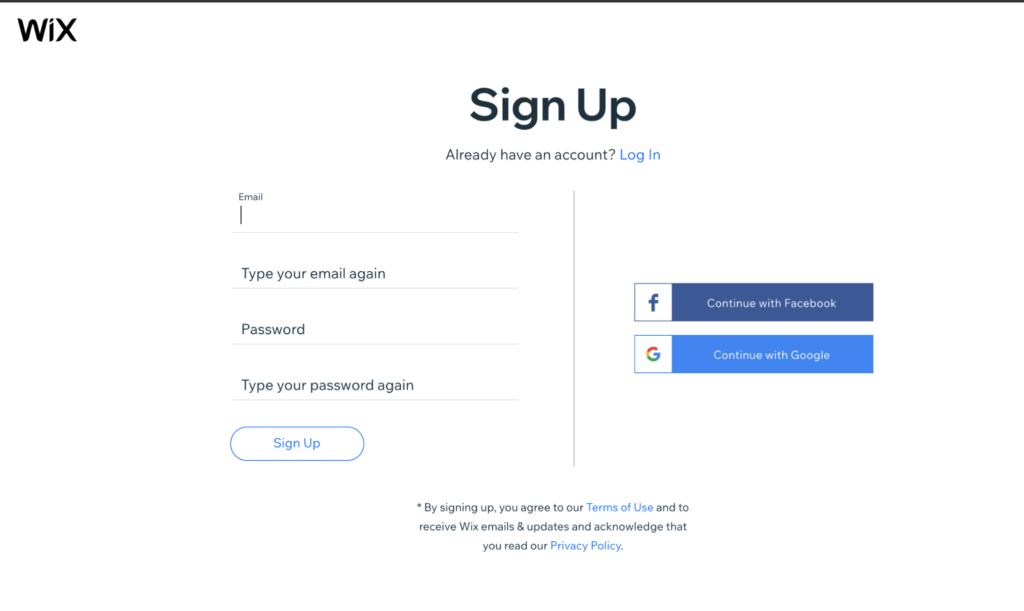
You’ll have to answer a few short questions about your new website before the sign-up is complete.
Step 2 — Select How to Create Your Website
Next, you’ll have to decide if you want to create a website within the Wix Editor or let the Wix ADI tool design one for you.
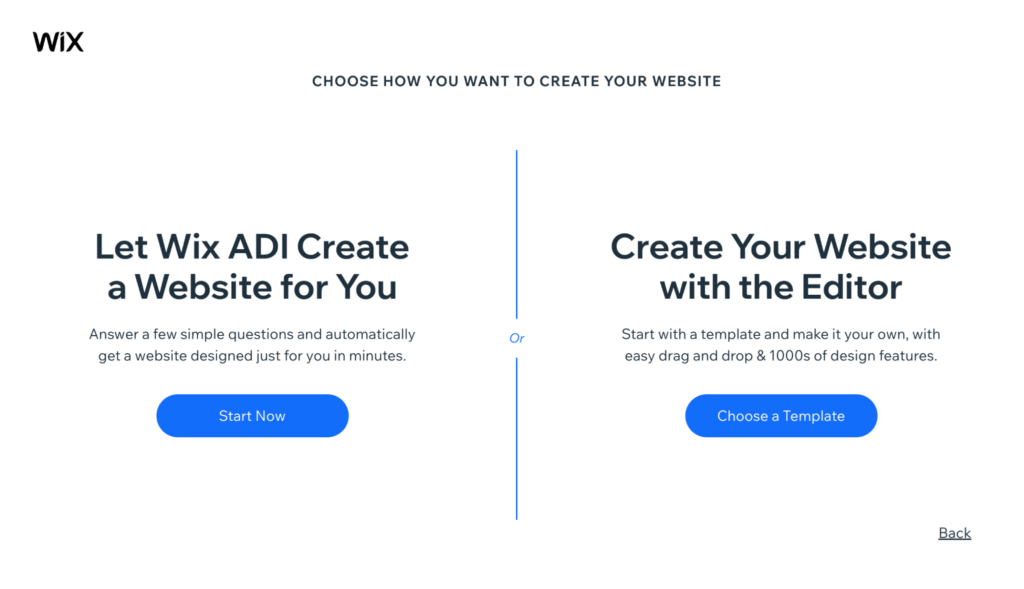
While helpful, Wix’s Artificial Intelligence Designer (ADI) tool has limited design and customization options compared to the Wix templates and editor. Therefore, if you have a basic understanding of website design and are confident in your web-building skills, click on Choose a Template.
If you’re a total newbie, the ADI tool may be a better option. In that case, select Start Now. You’ll have to answer a few questions about your new project to get appropriate customized solutions.
Here a brief overview of what you’ll see in the editor:
- Elements: You can click on an element to customize it, plus where you can change the images, write text, add buttons, and more.
- Add a Page: Go to Pages, and click on Add Page from the top menu bar. You’ll see a host of new page types and premade page templates. Select the one you like.
- Design: To change your website themes and layout or alter colors, fonts, and other elements, click on Design in the top menu bar.
Step 3 — Select a Wix Template
Assuming you decide to use Wix Editor, here’s what you need to do.
First, you have to pick the website template based on the type of site you want. You can filter the templates by category and view every template in demo mode to see what it looks like. Once you find a template you like that also fits your project, click Edit.
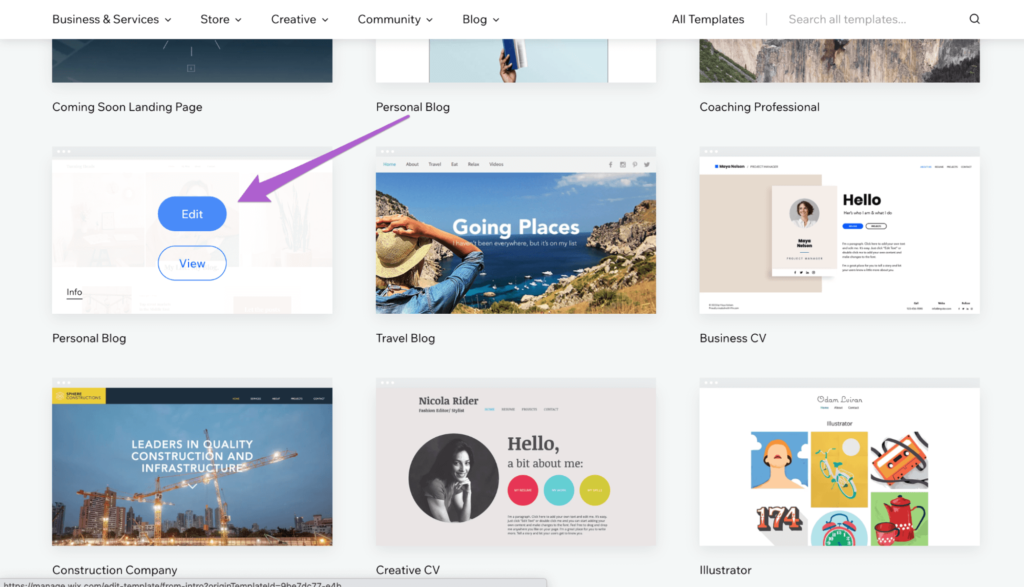
Step 4 — Customize Your Website
After you select a template, you can customize it on the Wix Editor using its drag-and-drop facility.
Click on any element on the page to alter its settings, reposition, or resize. You can also change colors, rewrite text, add images, and more. Anything you want, really. Any changes you make will appear in real-time, so you know exactly how your website looks to visitors.

The top menu bar is your one-stop destination to find some important Wix Editor features to customize your website.
- Page – This lets you toggle between your website pages and your blog.
- Desktop/Mobile – Use this to switch between desktop and mobile mode. It’ll be useful to edit your site for both devices.
- Settings – This is the place to be if you want to add a favicon, view site analytics, or simply make some tweaks.
- Save/Preview/Publish – You must always make a point to save your website as you go. Additionally, you can use this to preview your site on the front and publish it when you’re ready.

If you want to customize your website further, you can select any of the options on the left-hand side of the screen, including Pages, Background, Add, Theme Manager, Add Apps, Media, and My Blog.
Let’s decode each of these categories below:
Pages and Menu
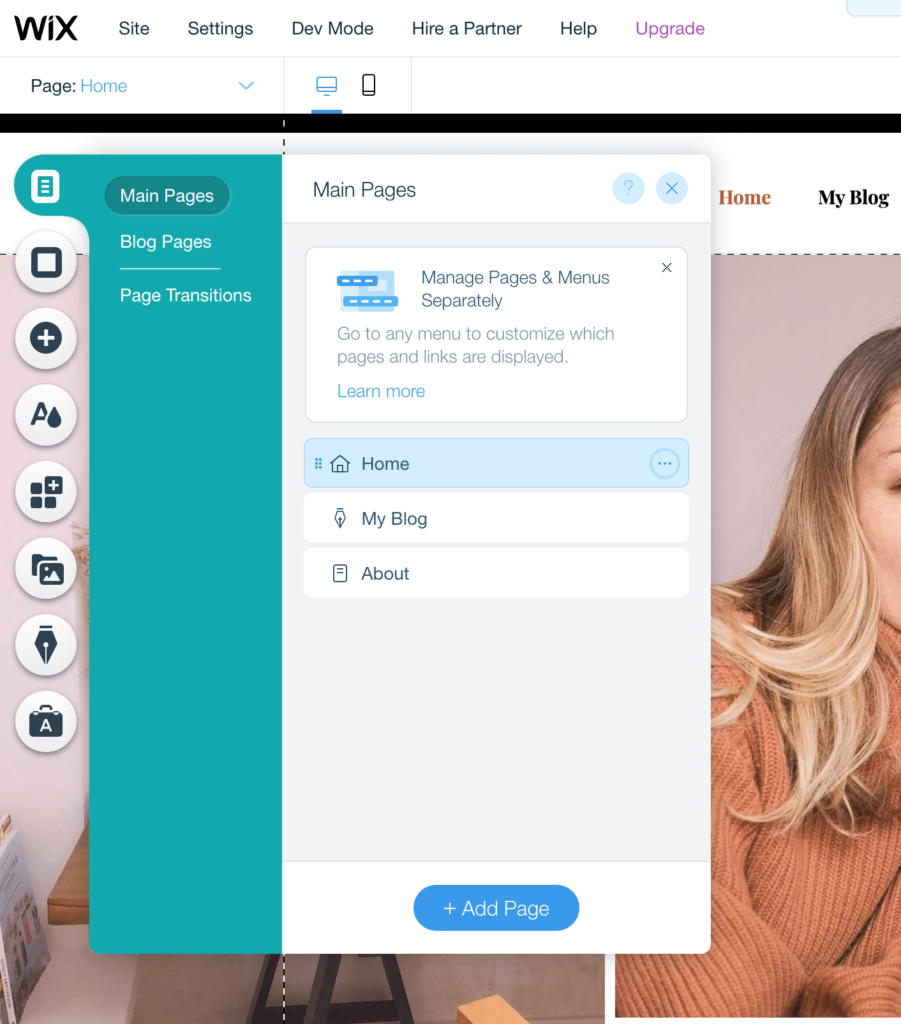
This is where you’ll find all your web pages.
Here, you can add new pages, hide, delete and rename pages, and change the order of how the pages appear in the menu. You can also access your pages’ Settings, namely:
- SEO – You can add metadata for all your web pages here. Doing this will help your content rank higher in the search engines.
- Social Share – This option allows you to include images and text that will be displayed whenever a specific page is shared on social media platforms.
- Permissions – This gives you control over who can view each page. You can also use it to create restricted content or members-only pages.
Background

You can change the background color or image, or display a video background—whatever you like—for your website here. Wix’s free media library has tons of attractive options, and you can upload your own media as well.
Elements
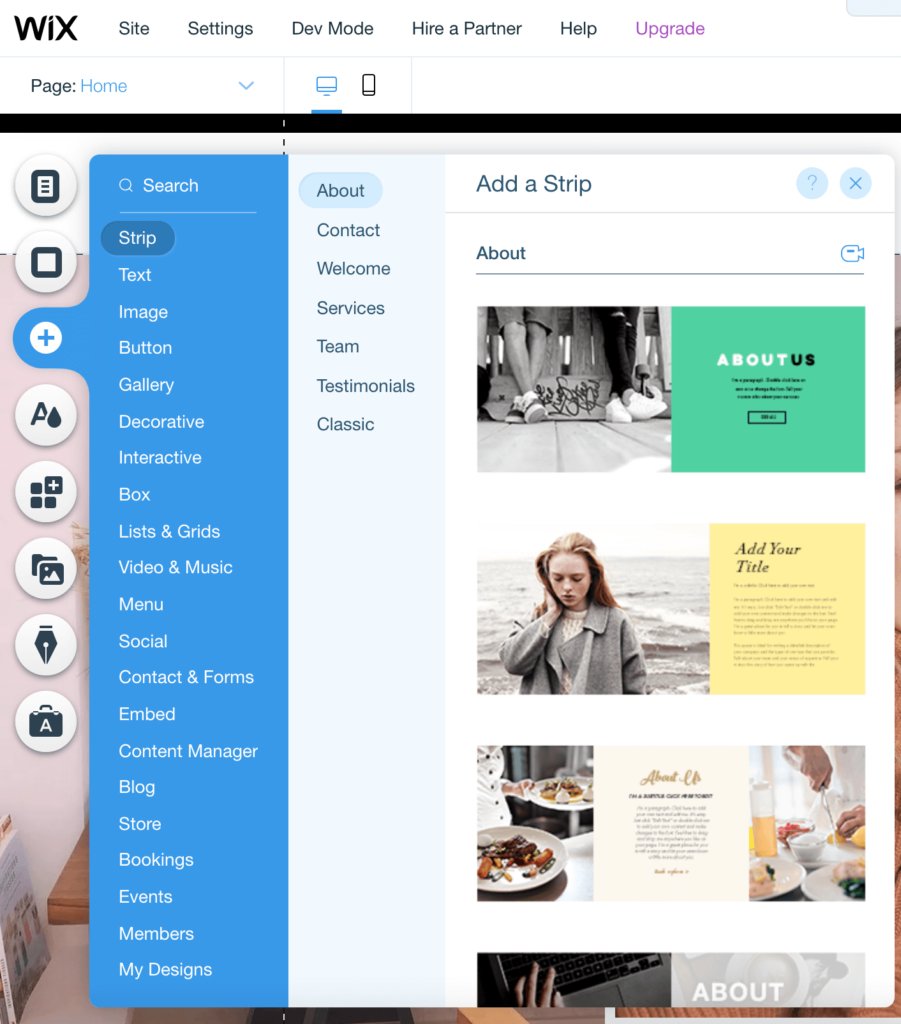
Clicking on Add will give you access to a wide assortment of elements that you can add to your website pages. These include:
- Galleries and images
- Interactive slideshows
- Videos and music
- Buttons
- Forms
- Boxes
- Grids
Adding elements to your website is a straightforward process. All you have to do is drag and drop it in the appropriate place on your web page.
Blog Manager
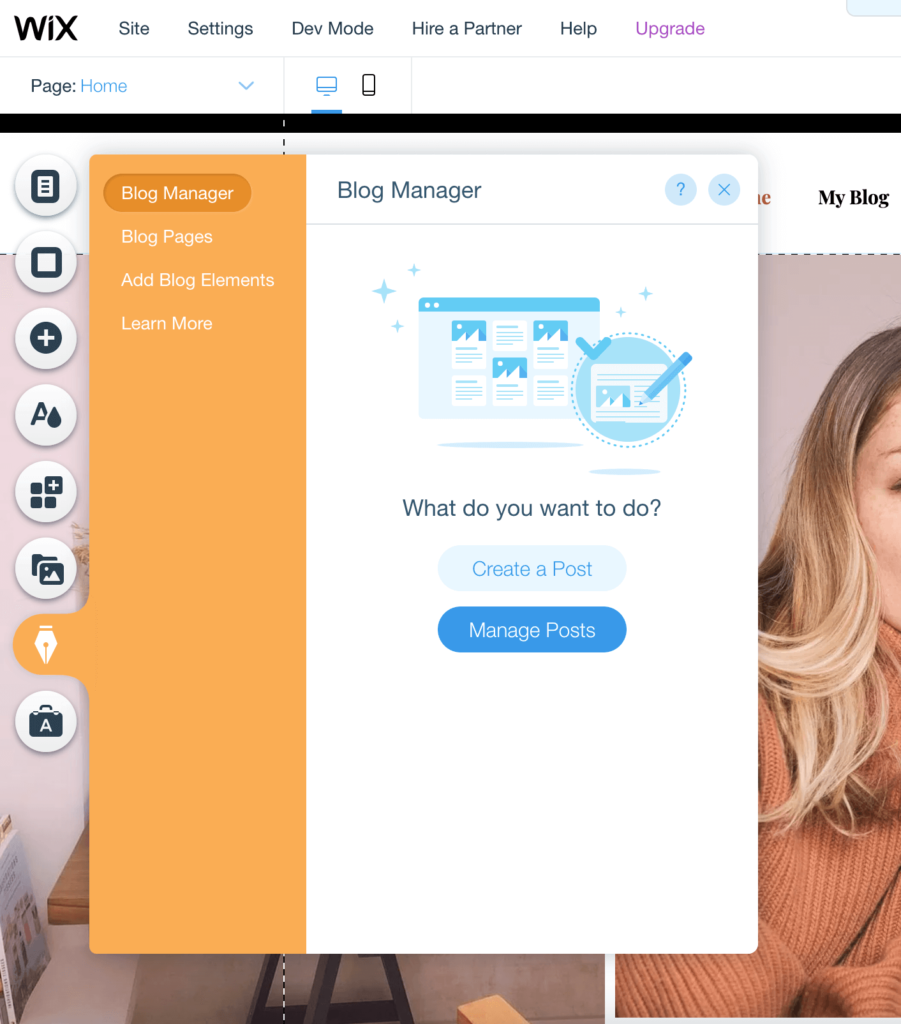
Click on Start Blogging to add a blog to your website. Follow that by clicking on Add Now. Doing this will add the Wix Blogging Manager app to your website.
Select Create New Post to add and publish new posts within the Blog Manager.
To view and manage your posts, go to My Blog, followed by Manage Posts.
Step 5 — Download Wix Apps to Improve Functionality
As mentioned previously, Wix has an innovative App Marketplace where you can download free and premium applications to boost your website‘s functionality.
To assess the marketplace, click on the Add Apps option from the left-hand side and then browse through the market to find options that interest you.
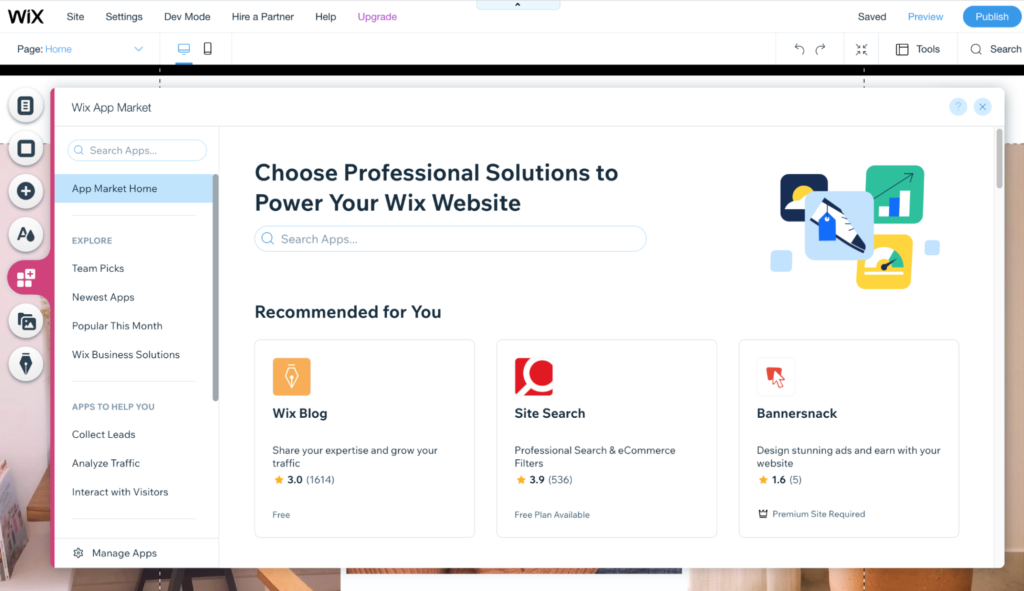
To add an app to your site, you’ll have to open the app page and click on Add to Site to start the installation process.
You’ll then want to play with it and see how it interacts with other elements on your site, as well as making sure the functionality is what you need. If not, you can delete the app and go back to the marketplace to find another one.
Step 6 — Publish Your Brand New Wix Website
At this stage, everything is done. You now have a website that not only looks great but also performs well. The last step is to publish it.
Select Publish on the top right-hand corner of your screen. Ta-Da! Your website is now live.
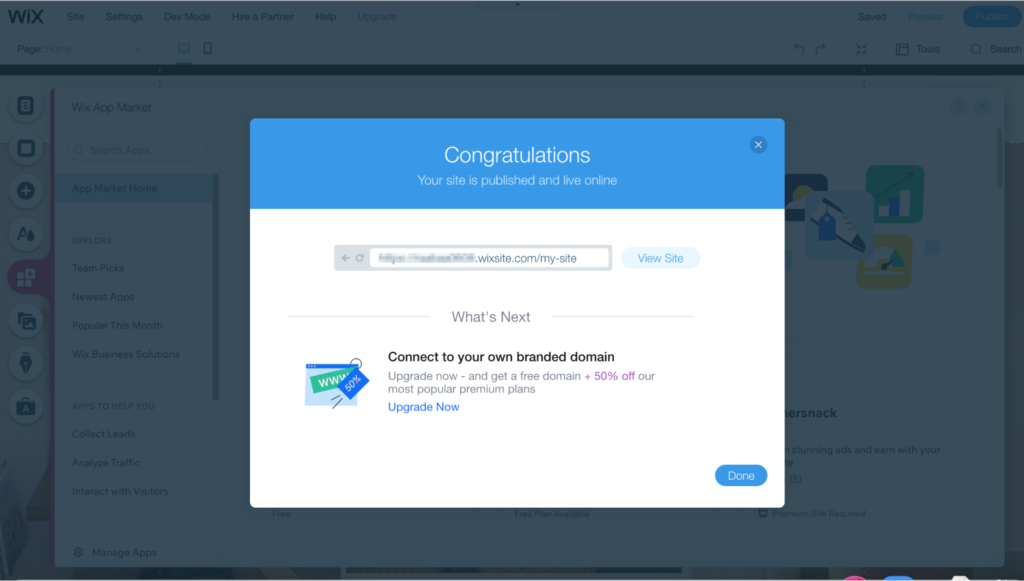
Remember: Wix lets you create a subdomain or connect to a custom domain. While the former is free, it’ll look something like this: username.wixsite.com/website.
Not very professional, right? It’s why we recommend using a custom domain you purchased from a reputable domain registrar.
Next Steps
Once the website is live, you can work on improving it. While you’re at it, make sure you optimize your web pages for search engines and optimize them for mobile phones.
If you don’t like your website’s design, you can make edits after publishing as well. Just go to your dashboard after signing in, click on My Sites, followed by Edit.
Want to take your Wix website to the next level? Read these Crazy Egg blogs to get started on the right track:

